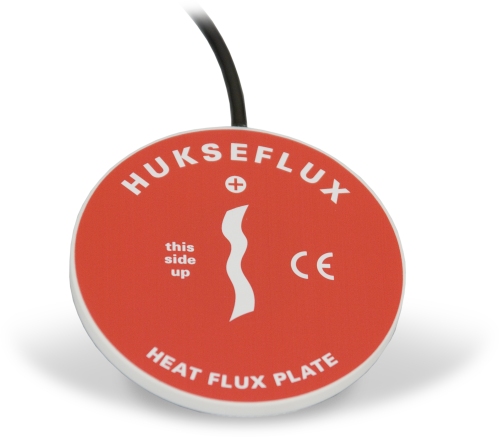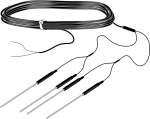
适用于能量平衡和波文比系统






概览
HFP01 测量土壤热通量,通常用于能量平衡系统或波文比通量系统。每个站点至少需要2个土壤热通量传感器,才能提供足够的空间平均。带有非均匀介质的站点可能需要更多的传感器。
优势与特点
- Compatible with most Campbell Scientific dataloggers
- Compatible with the CWS900-series interfaces, allowing it to be used in a wireless sensor network
图像



技术说明
HFP01使用热电堆来测量通过传感器板上的温度梯度。以完全被动的方式工作,传感器生成小的输出电压,与温差成比例。假设热通量是稳定的,传感器主体的热传导率为常数,以及传感器对热流量模式的影响可忽略,那么HFP01 的信号就直接与局地的热通量成比例。
HFP01输出毫伏信号,要将测量得到的毫伏信号转换成热通量,还需要将其除以传感器的校准常数。每个传感器出厂时都有唯一的校准常数。
产品规格
| Sensor Type | Thermopile |
| Sensitivity | 50 μV W-1 m-2 (nominal) |
| Nominal Resistance | 2 Ω |
| Temperature Range | -30° to +70°C |
| Sensor Thermal Resistance | < 6.25 x 10-3 K m2 W-1 |
| Measurement Range | ±2000 W m-2 |
| Expected Typical Accuracy | Within -15% to +5% in most common soils (12 hour totals) |
| Plate Diameter | 80 mm (3.15 in.) |
| Plate Thickness | 5 mm (0.20 in.) |
| Weight | 200 g (7.05 oz) without cable |
常见问题解答
HFP01-L: 5
展开全部收起全部
-
Yes, however, care must be taken to ensure a water-tight splice, such as by using an adhesive-lined heat shrink to cover the splice. This is important because splicing cable together increases the likelihood that water may enter the cable and cause shorting, corrosion, and some other potential issues, which can cause measurement issues.
Because of the potential issues, do not splice any sensor cable without first contacting Campbell Scientific to discuss the sensor in detail.
-
It depends on the sign convention used to describe heat flux through the wall. Heat flux that enters the red face and exits the blue face of the HFP01-L results in a positive analog output or positive heat. If the plate is already installed and it is desirable to use the opposite sign convention, change the sign of the multiplier to make it a negative value.
-
The information included on a calibration sheet differs with each sensor. For some sensors, the sheet contains coefficients necessary to program a data logger. For other sensors, the calibration sheet is a pass/fail report.
-
The HFP01-L uses a thermopile to measure flux across the plate. The output of a thermopile is proportional to the temperature gradient across the thermopile. The HFP01-L nominal calibration is 20 W m-2 /mV. The HFP01-L output voltage will depend on the temperature gradient (flux) across the plate.
-
Because of the loss of IR radiation, nearly all thermopile instruments typically have a negative offset. This offset is most easily visible at night-time, when a small negative value is read instead of zero. This same offset is present during the daytime, but it is not as visible because of the large solar signal.
Another common issue involves leveling an instrument. Leveling a thermopile instrument can cause errors in the direct beam component because the cosine response is not correct. These errors are more notable when the sun is close to the horizon because the angle is so shallow.
案例研究
The Utah Geological Survey, supported by the Utah Division of Water Rights, has constructed a......阅读更多
International partnerships for sustainable innovations Improved water use in agriculture is essential to successfully adapt to......阅读更多



